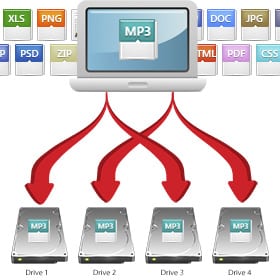 With more and more reliance on digital content, it’s not surprising that our storage needs are climbing right along with that reliance. But it’s not just a need for a higher volume of storage. Storage needs are also evolving, with a higher demand for faster and more secure storage.
With more and more reliance on digital content, it’s not surprising that our storage needs are climbing right along with that reliance. But it’s not just a need for a higher volume of storage. Storage needs are also evolving, with a higher demand for faster and more secure storage.
The more hard drives we use for our data, the more likely we are to suffer from a hard drive failure. Thus, a premium is placed on reliability to ensure that our important data is safe. This brings us to RAID.
So, what exactly is RAID?
RAID, or a Redundant Array of Independent Disks, is a type of storage solution that combines multiple hard drives into a cohesive system that appears to your computer as a single hard drive. A RAID setup can be generated by compatible hardware or even software.
Depending on your specific RAID setup, this can bring you increased speed, storage capacity, data security or a combination of these benefits.
Different types of RAID
There are several types of RAID, each with its own benefits and drawbacks. Selecting the right RAID solution for your workflow depends on your specific needs when it comes to performance, capacity and data security. Of the many types of RAID set ups, some are much more common than others.
Below are the RAID configurations that you are most likely to see in the wild along with their real world application benefits. Note: While there are several other RAID configurations, we will focus on the most common.
RAID 0: This array is referred to as “striping” and is a setup in which data is written across two hard drives with the main goal being speed. For example, a computer takes a file and splits it in half, with half written on drive 1 and half on drive 2. When you try to access the file, the computer requests the file from each drive and uses it as if it were on a single drive. Since there are two drives involved, there is an increase in read and write speeds because each drive is independently reading and writing the files for the OS.
With a single drive you are limited to the speed that specific drive can read and write, with two you are limited to the combined speed the two of them can reach independently. The only downside with this setup is that if one drive fails the files are rendered useless because each drive holds half of the data. Two different sized disks can be used in RAID 0, but the array is limited to the size of the smaller disk.
RAID 1: This array is referred to as “mirroring”, and as the name implies, data is wholly written on each drive, creating a mirrored copy of everything. Each file is fully written on drive 1 and drive 2. Very much 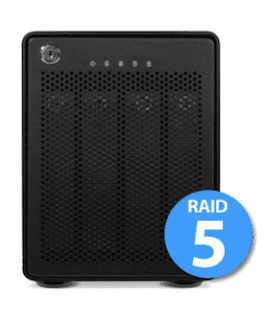 like a separate backup, if one drive fails there is an exact copy that can be used immediately. This configuration is for those who prioritize data security over storage capacity.
like a separate backup, if one drive fails there is an exact copy that can be used immediately. This configuration is for those who prioritize data security over storage capacity.
RAID 10: This configuration requires at least four drives and is a combination of RAID 1 and RAID 0. RAID 10 provides security by mirroring data on secondary drives while simultaneously using striping to speed up data transfers. For example, a 500 MB file is fully written twice, each time across two drives. The first 250MB on drives 1 and 2 and the second 250MB on drives 3 and 4. This gives the user the same speed increase as RAID 0 with the added benefit of having a mirror or backup of the same data. If a drive fails, there is a copy waiting to be used immediately. This option is for those who want the speed and capacity of striping and security of mirroring.
RAID 4: Not as commonly used, this configuration goes by the name “block-level striping with dedicated parity,” meaning that the parity information used to rebuild a failed disk is stored to a dedicated drive within the array.
RAID 5: This configuration is considered by many to be the best of all worlds. It provides speed, data security, and a failsafe in case a drive fails. Requiring only three drives, this setup is slightly more cost effective than RAID 10, while still providing the backup element in case of a drive failure.
Imagine a 500MB file is split in half and written across drives 1 and 2. The parts are then calculated into a formula, which is stored on drive 3, so that if drive 1 or 2 fails the information can be used to recreate the missing part of the data. The next file then is written across drives 2 and 3 with the formula stored on drive 1, and so forth. This RAID setup acts like a RAID 0 in that files are spread across drives, but gives the security of a RAID 1 and provides a fault-tolerance for a drive failure.
Other terms you may have heard
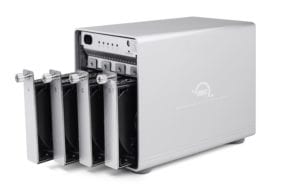 While RAID is quite popular, there are some other acronyms in this bowl of alphabet soup that are often incorrectly associated with RAID.
While RAID is quite popular, there are some other acronyms in this bowl of alphabet soup that are often incorrectly associated with RAID.
JBOD: JBOD simply means “Just a Bunch Of Disks/Drives”. In JBOD, each disk shows up as an individual logical volume on the computer. A 4 bay unit populated with drives will have 4 logical drives show up on the computer.
SPAN (N-RAID): SPAN combines the capacity of two or more drives of varying size without any RAID data distribution scheme into one logical desktop volume.
Is RAID necessary for you?
Well… it depends. If any of the benefits from the RAID arrays above such as better performance or data security would fit your workflow, then RAID can certainly work for you. However, even when configured for maximum security, we highly recommend that you have a complete backup plan for your data. You never know when disaster can strike. Be sure to keep your most important data secure.
Related article:
Beyond AppleRAID: SoftRAID Gives Data a New Software RAID Home
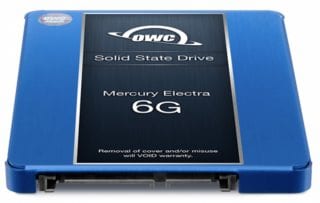

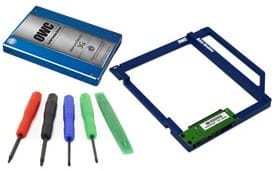






What about RAID 6?
Can OWC RAIDs support different size drives without loss of capacity? How about different manufacturers with the same tech. specs?
Pretty soon, RAID as we know it will be like using CDs/DVDs… (most really don’t use them anymore or don’t want to…)
New storage (file) systems are about to trickle down from enterprise to consumer desktops that also perform block-level verification (called checksums) that verify data on disk. Why? Because disk sizes are now getting so large that you’re statistically guaranteed to experience some form of block read/write error every ~12TB’s worth of reading/writing.
20 years ago, this number was essentially mythical for consumers, now; you can buy 10TB disks.
If you value your data, you can still buy the above non-hardware RAID units (i.e. JBOD) and start to use filesystems that perform checksum verification (and thus realtime repair when using multiple disks in an array) with the aid of your multiple-core CPUs to protect your data. ZFS is one example for OS X, but don’t take my word for it, as Apple have even announced they’re about to checksum/validate the metadata of their new filesystem. Not sure why they’re not verifying the data blocks also, but that’s clearly not far away either. If you have videos/photos that you want your kid’s kids to see, go do some homework.
“RAID 0
The only downside with this setup is that if one drive fails the files are rendered useless because each drive holds half of the data”.
Great review. Thanks.
How to edit these posts?
Actually, it is even worse: also if the controller fails.